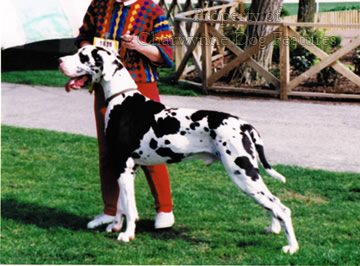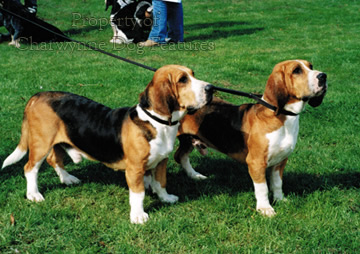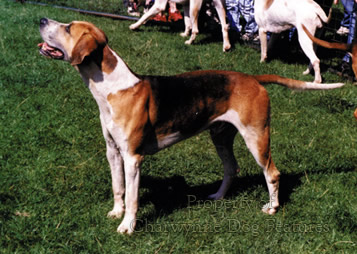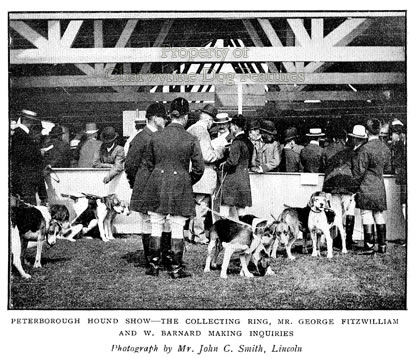854 KNOWING YOUR HOUND
KNOWING YOUR HOUND - Ignorance Is Not Bliss!
by David Hancock
 The Nature of the Structures
The Nature of the Structures
In his informative book The Dog: Structure and Movement, published in 1970, R.H.Smythe, a vet and exhibitor, wrote: "...many of the people who keep, breed and exhibit dogs, have little knowledge of their basic anatomy or of the structural features underlying the physical formation insisted upon in the standards laid down for any particular breed. Nor do many of them - and this includes some of the accepted judges - know, when they handle a dog in or outside the show ring, the nature of the structures which give rise to the varying contours of the body, or why certain types of conformation are desirable and others harmful." There are many misconceptions amongst show breeders and exhibitors; some concern the angulation of the hindquarters, some affect the thinking behind short legs in breeds like the Basset Hound and, more generally, the shoulder placement in scenthounds that rely on pace, sustained pace.
Show Ring Misconceptions
In every animal walking on four legs the force derived from pressing the hind foot into the ground has to be transmitted to the pelvis at the acetabulum, and onwards to the spine by way of the sacrum. In over-angulated dogs the locomotive power is directed to an inappropriate part of the acetabulum. In addition, so as to retain the required degree of rigidity of the joint between the tibia and the femur, other muscles have to come into use. In the over-angulated hind limb, the tibia meets the bottom end of the femur at such an angle that direct drive cannot ensue. The femur can only transmit the drive to the acetabulum after the rectus femoris muscle has contracted, enabling the femur to assume a degree of joint rigidity when connecting with the tibia. This means that the femur rotates anticlockwise whereas nature intended it to move clockwise. 
Excessive angulation in the hindquarters, with an elongated tibia, may, to some, give a more pleasing outline to the exhibit when 'stacked' in the ring. But, in the long term, it can only lead to anatomical and locomotive disaster. Such angulation destroys the ability of the dog's fore-limbs and hind-limbs to cooperate in harmony in propelling the body. Yet I have heard it argued by breed specialists at seminars that it will increase the power of propulsion operating through the hind-limbs and on through the spine. If it did, the racing Greyhound fraternity would have pursued it with great vigour. I have heard a dog show judge praise an over-angulated dog because it 'stood over a lot of ground'! So does a 'stretched limousine' but it requires a purpose-built construction to permit the luxury.
Discomforting Leg Construction
The Basset Hound, and the Dachshund, are examples of achondroplasic animals; achondroplasia is not a disease but an inherited condition in which the long bones of the leg do not attain normal length, disproportionate dwarfism in effect. Scientists tell us that the achondroplasic short-leg gene affects heavy bone more than fine bone and that it will therefore be more difficult to obtain a short-legged dog with straight legs if the bone is heavy than if it is light. It is not surprising therefore that the straight-legged English Basset of the hunting field has appreciably lighter bone than the crooked-legged standard show-type Basset. In their book, Medical and Genetic Aspects of Purebred Dogs (Forum, 1994), Clark and Stainer report that "The Basset Hound is placed in the chondrodystrophoid group of dogs. The conformation of the breeds in this category leads to many inherent problems. The most common problem in the Basset is the high incidence of shoulder and foreleg lameness. There appears to be a high incidence of osteochondritis dessicans. Deformities of the distal radius, ulna and carpal joint are frequently seen." Basset Hounds with excessively short crooked legs suffer; a sporting breed should not be bred to suit our whims but always to honour past function.
Importance of Shoulders
For me, the first point of real quality in a dog lies in clean sloping shoulders. Well-placed shoulders give a perfect base for a proud head carriage. They provide too the balance between the length of the neck and the length of the back, preventing those disagreeable dips in topline which mar the whole appearance of a dog. I learned, over the years, to start any judgement of the shoulders by considering the position of the elbow. If the elbow is too far forward, then the dog is pulling itself along, not pushing itself along, capitalising on the drive from the hocks and thighs, through the loins. The great foxhound expert, Capt Ronnie Wallace, in his video on the packhounds, states that the shoulders are controlled by the elbow. He knows his stuff; he bred superbly constructed hounds.
It is only when the scapula and the humerus are of the right length and correctly placed that a dog can achieve the desired length of stride and freedom in his front action. Sighthounds can have their upper arms 20% longer than their scapulae. In smaller breeds they tend to be equal in length. Dogs that step short in front are nearly always handicapped by upright shoulders and short steep upper arms. A dog of quality must have sloping shoulders and compatible upper arms to produce a good length of neck, a firm topline without dips, the right length of back and free movement on the forehand. The upper arm determines, with its length, the placement of the elbow on the chest wall. Many dogs that are loose at elbow are tight at the shoulder joint and the forelegs tend to be thrown sideways in a circular movement. If the dog is tight at elbow the whole leg inclines outwards, causing the dog to 'paddle'. I have seen this in Beagles, Bloodhounds and even Ridgebacks at conformation shows – and one or two have actually won their class! Had their judges ever seen a hunt? 
Show Ring Faults
When I first went to KC-approved championship dog shows over fifty years ago, the judges of hounds were often from the hunting field, men who knew the demands of the chase on scenthounds. In the 21st century this is rare and in time, as the hunting ban restricts experience, hounds at such shows are going to be judged by people with no knowledge of the field use of the hounds before them. This could be disastrous for the breeding of functional hounds. You only have to look at judges’s critiques in the last few years to see the falling away of standards in this Group of show dogs. The judge at The Basset Hound Club’s 2011 June show stated that, as in most places around the world, the front assembly in the breed is not correctly assembled, with short upper and fore-arms, leading to short-stepping. Such a fault is serious in a hunting dog relying on stamina to succeed. The judge at the Bloodhound Club’s show in that same month, and an ex-working trial owner, lamented the loss of true head shape in the breed, faulting the narrow muzzles on view at the show. I have previously written of the Richmond Show judge’s scathing remarks in the section on the Bloodhound. It was alarming to read of several Rhodesian Ridgeback judges reporting weak pasterns and even flat feet in the entry, not good news in a hunting breed.
Soundness before Beauty
For any hound carrying such disadvantages to be even taken to a KC show for hounds is disturbing. For the exhibitors to be seemingly unaware of such basic flaws is even more disturbing. Judges at such events have to ask themselves "Could the hound in front of me succeed in the hunting field?" A KC judge knows that the entry before him will be bred from. The late Sir Newton Rycroft once wrote in Hounds magazine: "...if a truly great breeder wins prizes at a big hound show in front of two good judges, all credit to him, he will never let it affect his breeding plans..." Wise words; hound shows have a role but it needs a concentration not on canine beauty but on structural soundness; but the judges have immense influence too, their mistakes or misconceptions affect breeding plans and therefore the future of a breed. 
In his valuable book Hounds and Hunting of 1937, Joseph B Thomas, a respected American MFH, wrote: "The British are the greatest breeders of livestock the world has ever seen or probably will see. They breed their mares to the winner of the Derby; they breed their greyhound bitches to the Winner of the Waterloo Cup; and yet they often breed their foxhound bitches to the Winner of the Peterborough Show, which winner is judged ...without regard to what this same animal can do in accounting for foxes, or whether he has cry or nose." Hound show judges can hardly be expected to judge cry or nose, but they are perfectly capable of spotting anatomical flaws that handicap a hunting dog and should be penalised not be rewarded. The immaculate turn-out of judges and hounds is very much part of the cosmetic appeal of such a show, but a rosette won after a wholly visual examination of noble hounds, mostly whilst there is an unseemly and rather degrading scrabbling for bits of biscuit is not going to earn real respect. We must be careful unless we pass on these precious hounds to future generations with inbred faults; judges at hound-shows can shape the future by settling on designs, rather like architects - who didn't become qualified by only 'staring at walls'!
Value of Hound Shows
The significance and the value of hound shows like Honiton, Rydal and Peterborough have long caused debate in the hunting world. A pack like the Berkeley elected not to show hounds. One Master in France is alleged to have bred two packs, one for showing and one for hunting, after finding disappointment when showing the hunting hounds. Some state that the racehorse has triumphed without the need for conformation shows, whilst others want to breed a pack rather than the odd outstanding hound. It has been pointed out to Hunts that the economy obtained from not showing does not lead to the sport suffering. The great hound expert Sir Newton Rycroft, in his Rycroft on Hounds, Hunting and Country of 2001, published by The Derrydale Press, writes that “If a successful and experienced Master arranges his matings without even thinking of Peterborough, he will, because he realizes how important foxhound conformation is for the essential virtues of pace, stamina and long hunting life, breed good-looking hounds. If such hounds are shown, it seems much more likely they will do good rather than harm, because they will have been bred for work only.” Hounds of the pack are tested for soundness, hounds shown at KC shows rarely are.
“The hound, to be well-made and beautiful, should have the head well-made and longer than it is broad; the forehead wide; the eye large and bright; the nostrils well-opened and moist rather than dry; the ear low, narrow, hanging down and curled inwards and longer than the nose by only two inches. The body of a size and length proportionate to the limbs so that without being too long it may be more slender than stocky; the shoulders neither too wide nor too narrow; the back broad, high and arched; the haunches high and wide; the stern broad near the back but terminating like that of a rat and loosely curved in a half-circle; the thighs well tucked up and well muscled; the leg vigorous, the foot lean and the nails thick and short. The height of hounds for the hare and the roe is from 21 to 23 inches; that of hounds for the stag from 25 to 28 inches; and that of hounds for the boar and wolf from 23 to 25 inches.”
From Hounds for a Pack by Comte Elie de Vezins (Allen, 1974, published originally in France in 1882.)
“Let us never forget that although shows are wonderfully happy occasions in the summer, as regards conformation they probably do more harm than good. Shows of sheep, pigs and cattle may well be helpful for the butcher and the breeder can see in the animals the qualities he wants. Not so with hounds; all the most desirable qualities – nose, constitution, voice and brain – are totally invisible.”
From an article by Philip Burrows in Hounds magazine, December issue, 1989.
(He went on to state that he had tried to show only his very best working hounds, but (because the hound shows had become purely ‘beauty shows’), he had been ‘laughed out of court and had to give up’.”
“Hounds should combine strength with beauty, and steadiness with high mettle. Perfection of shape consists in short backs, open bosoms, straight legs, and compact feet. The first qualities of hounds are fine noses, docile tempers, steadiness to their game and stoutness in chase.”
From The Life of a Sportsman by Nimrod, (Methuen, 1903)
“The two things it is impossible to judge in the show ring are nose and voice. Are there any more important qualities in a hound (apart from drive)? So when I am told of Masters going to the kennels of Peterborough dog champions and asking if they can use them on their bitches, without first at least asking how they perform in the field, my heart sinks. Even worse, I have heard stories of such people being told that the dog’s brother is better in his work, but then still insisting on using the champ. If you breed enough litters on this basis, the chances are you will get something half decent enough to show – breed a few more litters and you might get a hunting pack as well.”
From Hounds Magazine November issue 2012, in an article by Al Lonsir